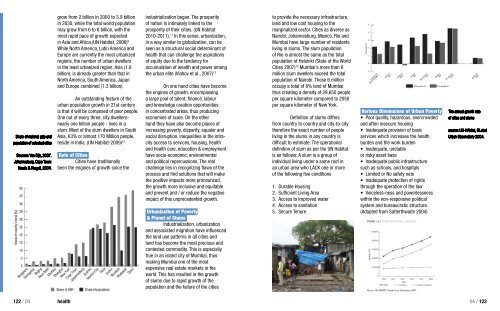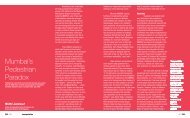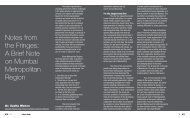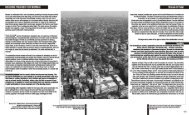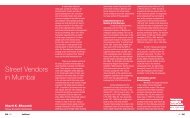Share <strong>of</strong> national gdp andpopulation <strong>of</strong> selected citiesSources: Van Dijk, 2007.Johannesburg, Cape Town:Naude & Krugell, 2004.grow from 2 billion in 2000 to 3.9 billionin 2030, while <strong>the</strong> total world populationmay grow from 6 to 8 billion, with <strong>the</strong>most rapid pace <strong>of</strong> growth expectedin Asia and Africa.(UN Habitat, 2006) 9While North America, Latin America andEurope are currently <strong>the</strong> most urbanizedregions, <strong>the</strong> number <strong>of</strong> urban dwellersin <strong>the</strong> least urbanized region, Asia (1.8billion), is already greater than that inNorth America, South America, Japanand Europe combined (1.3 billion).An outstanding feature <strong>of</strong> <strong>the</strong>urban population growth in 21st centuryis that it will be composed <strong>of</strong> poor people.One out <strong>of</strong> every three, city dwellersnearlyone billion people - lives in aslum. Most <strong>of</strong> <strong>the</strong> slum dwellers in SouthAsia, 63% or almost 170 Million people,reside in India. (UN Habitat-2009) 10Role <strong>of</strong> CitiesCities have traditionallybeen <strong>the</strong> engines <strong>of</strong> growth since <strong>the</strong>industrialization began. The prosperity<strong>of</strong> nation is intimately linked to <strong>the</strong>prosperity <strong>of</strong> <strong>the</strong>ir cities. (UN Habitat2010-2011). 11 In this sense, urbanization,in a way similar to globalization, can beseen as a structural social determinant <strong>of</strong>health that can challenge <strong>the</strong> aspirations<strong>of</strong> equity due to <strong>the</strong> tendency foraccumulation <strong>of</strong> wealth and power among<strong>the</strong> urban elite (Vlahov et al., 2007) 12On one hand cities have become<strong>the</strong> engines <strong>of</strong> growth, encompassinga large pool <strong>of</strong> talent, finance, labourand knowledge creation opportunitiesin concentrated areas, thus producingeconomies <strong>of</strong> scale. On <strong>the</strong> o<strong>the</strong>rhand <strong>the</strong>y have also become places <strong>of</strong>increasing poverty, disparity, squalor andsocial disruption. Inequalities in <strong>the</strong> intracityaccess to services, housing, healthand health care, education & employmenthave socio-economic, environmentaland political repercussions. The realchallenge lies in recognizing flaws <strong>of</strong> <strong>the</strong>process and find solutions that will make<strong>the</strong> positive impacts more pronounced,<strong>the</strong> growth more inclusive and equitableand prevent and / or reduce <strong>the</strong> negativeimpact <strong>of</strong> this unprecedented growth.<strong>Urban</strong>ization <strong>of</strong> Poverty& Planet <strong>of</strong> SlumsIndustrialization, urbanizationand associated migration have influenced<strong>the</strong> land use patterns in all cities andland has become <strong>the</strong> most precious andcontested commodity. This is especiallytrue in an island city <strong>of</strong> Mumbai, thusmaking Mumbai one <strong>of</strong> <strong>the</strong> mostexpensive real estate markets in <strong>the</strong>world. This has resulted in <strong>the</strong> growth<strong>of</strong> slums due to rapid growth <strong>of</strong> <strong>the</strong>population and <strong>the</strong> failure <strong>of</strong> <strong>the</strong> citiesto provide <strong>the</strong> necessary infrastructure,land and low cost housing to <strong>the</strong>marginalized sector. Cities as diverse asNairobi, Johannesburg, Mexico, Rio andMumbai have large number <strong>of</strong> residentsliving in slums. The slum population<strong>of</strong> Rio is almost <strong>the</strong> same as <strong>the</strong> totalpopulation <strong>of</strong> Helsinki (State <strong>of</strong> <strong>the</strong> WorldCities 2007) 13 Mumbai’s more than 6million slum dwellers exceed <strong>the</strong> totalpopulation <strong>of</strong> Nairobi. These 6 millionoccupy a total <strong>of</strong> 8% land <strong>of</strong> Mumbaithus creating a density <strong>of</strong> 29,650 peopleper square kilometer compared to 2050per square kilometer <strong>of</strong> New York.Definition <strong>of</strong> slums differsfrom country to country and city-to-city<strong>the</strong>refore <strong>the</strong> exact number <strong>of</strong> peopleliving in <strong>the</strong> slums in any country isdifficult to estimate. The operationaldefinition <strong>of</strong> slum as per <strong>the</strong> UN Habitatis as follows: A slum is a group <strong>of</strong>individual living under a same ro<strong>of</strong> inan urban area who LACK one or more<strong>of</strong> <strong>the</strong> following five conditions1. Durable Housing2. Sufficient Living Area3. Access to Improved water4. Access to sanitation5. Secure TenureVarious Dimensions <strong>of</strong> <strong>Urban</strong> Poverty• Poor quality, hazardous, overcrowdedand <strong>of</strong>ten insecure housing• Inadequate provision <strong>of</strong> basicservices which increases <strong>the</strong> healthburden and <strong>the</strong> work burden• Inadequate, unstableor risky asset base• Inadequate public infrastructuresuch as schools, and hospitals• Limited or No safety nets• Inadequate protection <strong>of</strong> rightsthrough <strong>the</strong> operation <strong>of</strong> <strong>the</strong> law• Voiceless-ness and powerlessnesswithin <strong>the</strong> non-responsive politicalsystem and bureaucratic structure.(Adopted from Satterthwaite 2004)The annual growth rate<strong>of</strong> cities and slumssource: UN-HAbitat, GLobal<strong>Urban</strong> Observatory 2004.122 / 04 health04 / 123
<strong>Urban</strong> <strong>Design</strong> & <strong>Health</strong>“The urban setting is a lensthat magnifies or diminishes o<strong>the</strong>rsocial determinants <strong>of</strong> health. <strong>Urban</strong>environments have a number <strong>of</strong>contextual and compositional attributessuch as size, density, complexity andverticality that affects health equity inboth positive and negative ways.” KNUS14While social and economic conditionsare vitally important, <strong>the</strong>re is a growingbody <strong>of</strong> work across <strong>the</strong> disciplines thatrecognize <strong>the</strong> role <strong>of</strong> physical urbanenvironment in shaping health anddiseases and thus in contributing tohealth equities (Galea & Vlaho 2005 ) 15Visible and invisible spatialborders that transpire into segregation<strong>of</strong> <strong>the</strong> society according to socioeconomicconditions <strong>of</strong>ten divide cities.According to UN Habitat 2010‐2011,‘Closer assessment <strong>of</strong> <strong>the</strong>urban space in many cities <strong>of</strong> <strong>the</strong>developing world unambiguouslyexposes <strong>the</strong> fragmentation <strong>of</strong> <strong>the</strong>society with clear differences in <strong>the</strong> wayspace and opportunities are produced,appropriated, transformed and used’.Some areas features significantinfrastructure, well kept parks, gardensand clean well built residential areas. Incontrast, o<strong>the</strong>r areas are characterizedby sever deprivation, inadequate housingdeficient services, poor recreationaland cultural facilities, urban decay andscarce capital expenditure. This kind<strong>of</strong> spatial injustice has tremendousimpact on <strong>the</strong> health <strong>of</strong> <strong>the</strong> residents.It is in this context that <strong>the</strong> urbandesign has a critical role to play.<strong>Urban</strong> planning and design orlack <strong>of</strong> it can create very different urbanenvironments that can impact health in apositive or negative way. In all countriespoor end up living in unhealthy places…down stream, down wind, in low layinglands, in flood plains, in landslides, overgarbage dumps, near polluting factories.In <strong>the</strong> city <strong>of</strong> New York all <strong>the</strong> bus depotsare located in Harlem, where <strong>the</strong> AfricanAmerican people are concentrated.Most slum dwellers inMumbai are located along <strong>the</strong> railwaytracks, over <strong>the</strong> dumping grounds,or near flooding areas. It has beennoted that ‘Disparities in health areincreasingly linked to <strong>the</strong> physical andsocial environment that fall under <strong>the</strong>domain <strong>of</strong> planning (Corburn 2004)The issue that can be moderatedthrough urban design and planning:Land use patters, designing<strong>of</strong> infrastructures, both s<strong>of</strong>t and hard,density and location <strong>of</strong> facilities and safeneighbourhoods. Availability or lack <strong>of</strong>this has severe impact on <strong>the</strong> physicaland mental health <strong>of</strong> <strong>the</strong> residents.<strong>Urban</strong> planning and <strong>the</strong>regulatory framework it provides on landuse, land development, housing andbuilding standards and infrastructurestandards should reduce inequities inliving conditions. Their core purpose is toensure health and safety, including landuseregulations that prevent buildingson unsuitable sites (for instance, floodplains), and ensure that land is availablefor infrastructure and services and open/public space (Barton & Tsouros, 2000) 16 .Six pathways for designinghealthy cities1. Equitable Access toBenefits <strong>of</strong> <strong>Urban</strong> life:Assess to livelihood opportunitiesare critical to people’s health. Longand expensive commute to workingplace and lack <strong>of</strong> easy access totransportation impact both <strong>the</strong> physicaland <strong>the</strong> economic conditions <strong>of</strong> <strong>the</strong>family and makes urban poor vulnerableto unemployment. Spatial mismatchbetween job location and place <strong>of</strong>residence can leave more remote slumdwellers little alternative but to spenda night in public space, squat in <strong>the</strong>temporary unit devoid <strong>of</strong> services. In Riosome workers sleep on benches duringweek saving commuting time as wellas transportation costs that consume20% <strong>of</strong> <strong>the</strong>ir earnings. In Mexico city20 % <strong>of</strong> workers spend more than 3hours commuting to and from workeveryday. (State <strong>of</strong> World cities 2010/11)In an affluent country like US,traffic congestion cost $ 4.27 Billion inextra fuel and person hours in Chicagoin 2003 (<strong>Urban</strong> Mobility Report, TexasTransportation Institute). On <strong>the</strong> o<strong>the</strong>rhand Victoria Transport Policy in Australiastates that public transit in cities cansave $279 per capita in congestions costsavings. This identifies <strong>the</strong> importance<strong>of</strong> infrastructure. (GRNUHE) 17Traffic accidents are also on<strong>the</strong> rise in <strong>the</strong> cities. Between 1975-1998 traffic fatalities increased by237.1 % in Columbia, 243 % in Chinaand 338% in Botswana. Many who diein traffic accidents are pedestrians.In Mumbai where 6.5 million workerstravel on <strong>the</strong> commuter trains, 19persons are killed each day in trainrelated accidents (Uncovering <strong>the</strong>Myth <strong>of</strong> <strong>Urban</strong> Development inMumbai’ by Dr. S. Parasuraman) 18 .Better urban infrastructure,pedestrian friendly streets and wellplanned transport system that providesafe options for getting around <strong>the</strong>city are needed to curb <strong>the</strong> rise in<strong>the</strong> traffic Deaths (UN Habitat, State<strong>of</strong> <strong>the</strong> World’s Cities, 2006/7).O<strong>the</strong>r critical access is for <strong>the</strong>health care services and facilities. In poorareas <strong>the</strong>re are no health care facilitiesavailable. In Kaula Bandar, a 40 years oldunregistered slum in Mumbai PUKAR hasfound out that <strong>the</strong>re is no primary schoolin this community <strong>of</strong> 15000-18000 peopleand <strong>the</strong> nearest health service deliveryfacility is 1.5 kms away with no publictransportation available to reach thatfacility. (June 2010 Report to RockefellerFoundation, Unpublished data). Researchin higher income countries has revealedthat in densely populated cities <strong>the</strong>124 / 04 health04 / 125


